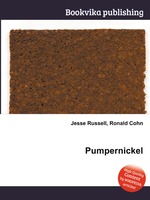Pumpernickel
Jesse Russell Ronald Cohn
бумажная книга
High Quality Content by WIKIPEDIA articles! Pumpernickel is a type of very heavy, slightly sweet rye bread traditionally made with coarsely ground rye. It is often made with a combination of rye flour and whole rye berries. It has been long associated with the Westphalia region of Germany. The first written mention of the black bread of Westphalia was in 1450. Although it is not known whether this, and other early references, refer to precisely the bread that came to be known as pumpernickel, there has long been something different about Westphalian rye bread that elicited comment. The defining characteristics of Westphalian pumpernickel are coarse rye flour—rye meal—and an exceedingly long baking period. The long slow baking is what gives pumpernickel its characteristic dark colour. The bread can emerge from the oven deep brown, even black. Like most all-rye breads, pumpernickel is traditionally made with a sourdough starter; the acid preserves the bread structure by counteracting the highly active rye amylases. That method is sometimes augmented or replaced in commercial baking by adding citric acid or lactic acid along with commercial yeast.


